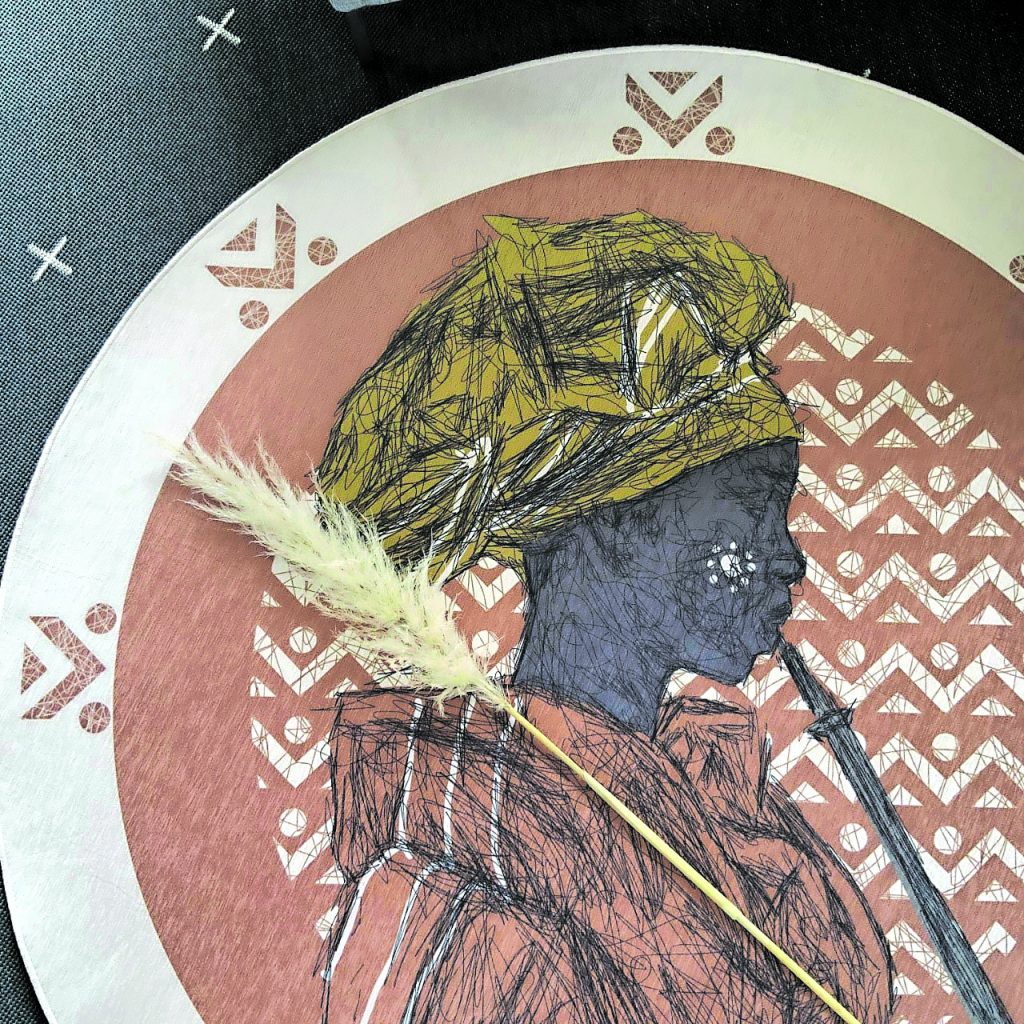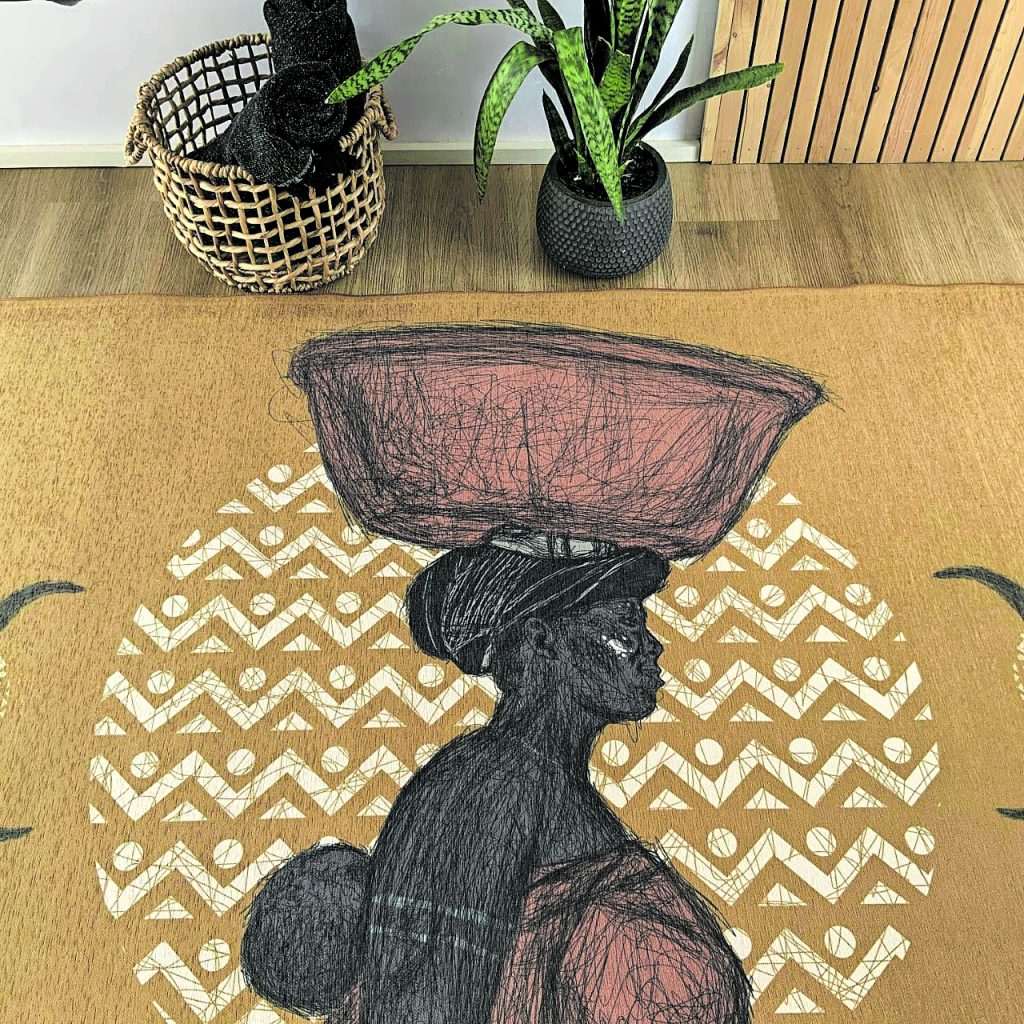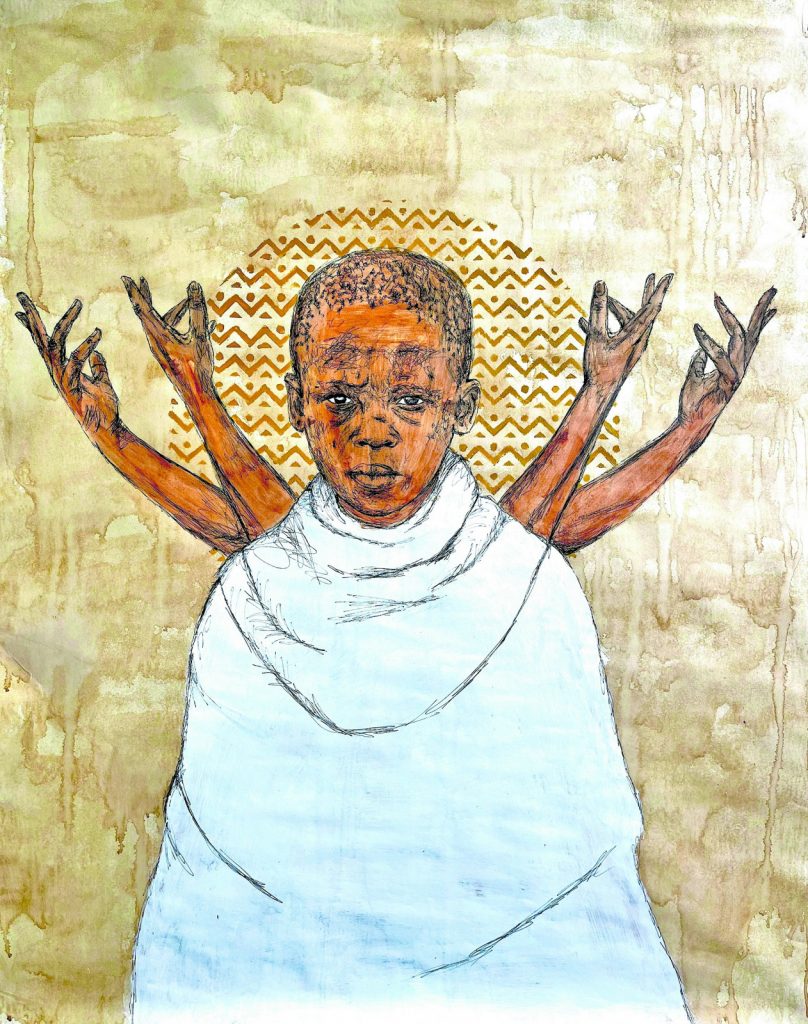Designer and illustrator Masonwabe Ntloko. (Supplied)
‘With my work, I aim to tell stories of today and of back then but also to create a future where Africanism can exist in a futurist way’
One of the grim realities of album artwork these days is how they are often glanced at and quickly forgotten.
Not only has our collective attention span dissipated, artists also seem to invest less in them and fans no longer pay as much attention as they did when people such as photographer and visual artist Jonathan Mannion were famous for their work on album art for the likes of Jay-Z, Eminem and a host of other stars.
But the artwork for Atteridgeville rapper 25K’s album Pheli Makaveli felt different. When his debut effort was unveiled in 2021, he made a moment of it. And that effort paid dividends as it was lauded by music fans the country over for its artistic genius and, in the process, helped drive interest in the music.
It felt instantly iconic. And not only because of the striking image of 25K rubbing his hands together while having his locks trimmed, but because of the font, the colour and the design, all of which neatly tied in to 25K’s refreshingly extensive visual roll-out. Behind this creative direction and design was Eastern Cape-born illustrator and designer Masonwabe Ntloko.
He was no stranger to working on album covers — just a year prior Ntloko had done the slick and striking artwork for Simphiwe Dana’s Bamako. Over the past year, Ntloko’s endeavours have extended beyond doing covers and into numerous other artistic forms.
Throughout last year, Ntloko worked on several collaborations, including a recent one with Airloom through which he dropped a stunning limited-edition rug collection titled Ilifa Lethu, which translates to “our inheritance”.
Influenced and inspired by his mom, Tabisa Ntloko, he warmly describes it as “an open letter to my mother and all the loving mothers out there.
“This body of work is an embodiment of a mother’s love.”
Much of the 26-year-old’s work is centred around his pride in his culture and his people, amaXhosa.
Perhaps even more impressively, earlier in the year, as Warner Music South Africa rebranded itself to Warner Music Africa, Ntloko was tasked with redesigning the company’s brand as it entered a new age.

 New foothold: The artist branched with the Ilifa Lethu rug collection for Airloom, which he says was inspired by his mother and aunt.
New foothold: The artist branched with the Ilifa Lethu rug collection for Airloom, which he says was inspired by his mother and aunt.
New foothold: The artist branched with the Ilifa Lethu rug collection for Airloom, which he says was inspired by his mother and aunt.
He used the opportunity to produce an identity for the company that not only represented his own heritage but also celebrated the rich, complex and dynamic beauty of African creativity.
After an incredible 2022, these days his name is evoked with reverence for his unique style across a sprawling design portfolio.
“I’m desperate for a rug or an artwork,” Friday editor Lerato Tshabalala said when I mentioned I was keen to interview him.
Last month, Ntloko posted a video on social media of musician and member of Destiny’s Child, Kelly Rowland, visiting him at his Johannesburg studio.
“That’s so beautiful, I can never walk on this,” comments Rowland, while taking a photograph of his Tabisa rug.
When I got the chance to speak to Ntloko, we chatted about his journey, inspiration, background and his stellar designs over the past few years.
 Giving back: Ntloko draws on his pride in his Xhosa culture and his people when making art, with the aim of teaching others about it.
Giving back: Ntloko draws on his pride in his Xhosa culture and his people when making art, with the aim of teaching others about it.
Let’s start at the very beginning. How did you first become interested in the art space?
To be honest, my love for art started at a very young age. I was probably in grade three and it all started with drawing Dragon Ball Z characters. I haven’t stopped since.
At what point did you realise this was something you could do as a profession?
As soon as I saw I was good at it, it became the only thing I cared about. At that age, I didn’t know much about art. All I knew is I wanted to continue to draw for the rest of my life.
How would you generally describe your style of design?
My style focuses on simplicity and is heavily influenced by culture and where I come from.
With my work, I aim to tell stories of today and of back then but also to create a future where Africanism can exist in a futurist way because my work doesn’t just take from culture; my aim is to contribute too.
I first came across your work through your designs for companies such as Universal and Sony. How did you get involved in the world of entertainment?
 Giving back: Ntloko draws on his pride in his Xhosa culture and his people when making art, with the aim of teaching others about it.
Giving back: Ntloko draws on his pride in his Xhosa culture and his people when making art, with the aim of teaching others about it. It all started in 2017 when Jay Kayembe gave me an opportunity to work on a show he had with Frank Casino and Castle Lite as an illustrator for an exhibition they had at Agog Gallery.
Then, from there, it was Shane Eagle’s Yellow Tour. For that one, I was the art director and worked on the entire corporate identity of the tour, including designing my first Hype Magazine cover.
Which of your designs are your favourites and why?
I’d say Simphiwe Dana’s Bamako, Zoocci’s Anxiety, Pheli Makaveli by 25K and De Mthuda’s The Landlord.
The projects mentioned above were projects where I was trusted to come up with the brief myself and allowed to be free and creative.
Talk me through your process and inspiration for Pheli Makaveli.
Mid 2020, Zoocci called me about a project he was working on with Kilo (25K) and asked me to work on it with him. I joined the team as a creative director and designer and got my friend Lihle Menziwa to be the photographer.
The concept was simple — we did not want to overly design the project. We wanted to create an art piece that told the story of Kilo and where he comes from. That’s why we had to shoot it in Atteridgeville.
Since then you seem to have evolved past album artwork designs. Is this the case and, if so, how come?
Right now, my focus is my career. I’ve chosen to be selfish about my time and talent because, as much as I love the music industry, I’ve also learnt it can be very cruel and, to be honest, the work designers put in is looked down upon and not respected.
So, I got tired of trying to convince labels and artists to respect what we do and pay us accordingly. That’s not my fight to fight anymore. I do sometimes work on music projects for the love of it but I don’t think I’ll ever focus on it again. It’s not worth all the stress and disrespect.
A few of my favourite things: Ntloko sees some of the album covers he has designed as high points of his career.
Last year you helped revamp and rebrand Warner Music Africa. How did you come to be involved in that project?
Because I’ve been in the music industry before, I’ve met and worked with a lot of the guys and when I made my shift to focus on my art some of those relationships continued.
One of them was with Garth [Brown], label manager at Warner. When they had the idea, they called me. Making the decision to focus on myself was not an easy one, but when things like this [collaboration] happen, it means I’m on the right track. Also, coming back to the music industry as a talent was really cool.
Tell me about your partnership with Rocking the Daisies.
I approached them, pitched the idea and they agreed to do it.
When we worked on the project, it was really challenging and not for the reasons you’d think. They gave me all the creative power and sometimes having that level of creative freedom can be a very tricky situation but, in the end, I decided to stay true to myself and do what represents my work.
You were part of the first instalment of Nix Mapha a few months ago. What was that all about?
It was an experience I curated with Fred Kayembe for Youth Day which focused on creating an environment that spoke to the inner child. The idea was to create a space where everyone was free to express themselves.
Talk me through your collaboration with Airloom and your work in the rug space.
Ilifa Lethu is the rug collection that I worked on with Airloom.
As black people who come from less fortunate backgrounds, we do not have a lot that we receive from our parents in terms of materialistic possessions but we are rich in culture and knowledge and that is what I have inherited from my family and those who came before me.
The idea is to teach this knowledge to others but, in an artistic way, that’s what Ilifa Lethu is — the beginning of me teaching.
My mother and my aunt were the inspiration behind this [rug] drop.
You were nominated for a Loerie Award last year. How did that feel?
It was a reaffirming moment because I’m a guy who decided to create my own path, and for an institution like the Loeries to see what I do, I felt like it deserves to be in the same conversation with all the conventional creatives (who did things the traditional way); this means I’m doing something right.
What do you consider the highlight of your career?
My mom sees everything come full circle. At some point, she was the only person who believed in my vision. She didn’t really understand it, but she believed.
To learn more about this visual artist visit: https://www.masonwabentloko.com/.